Embark on an enlightening journey with the Wind Power Kit Science Olympiad, an extraordinary platform where innovation and scientific inquiry converge. This comprehensive guide delves into the intricacies of wind power, empowering you with knowledge and inspiration to harness the boundless energy of the wind.
Discover the fundamental components of a wind power kit, unravel the principles of wind turbine design, and witness the remarkable process of wind power generation. Explore diverse applications of wind power, weighing its advantages and disadvantages against other renewable energy sources.
Wind Power Kit Components
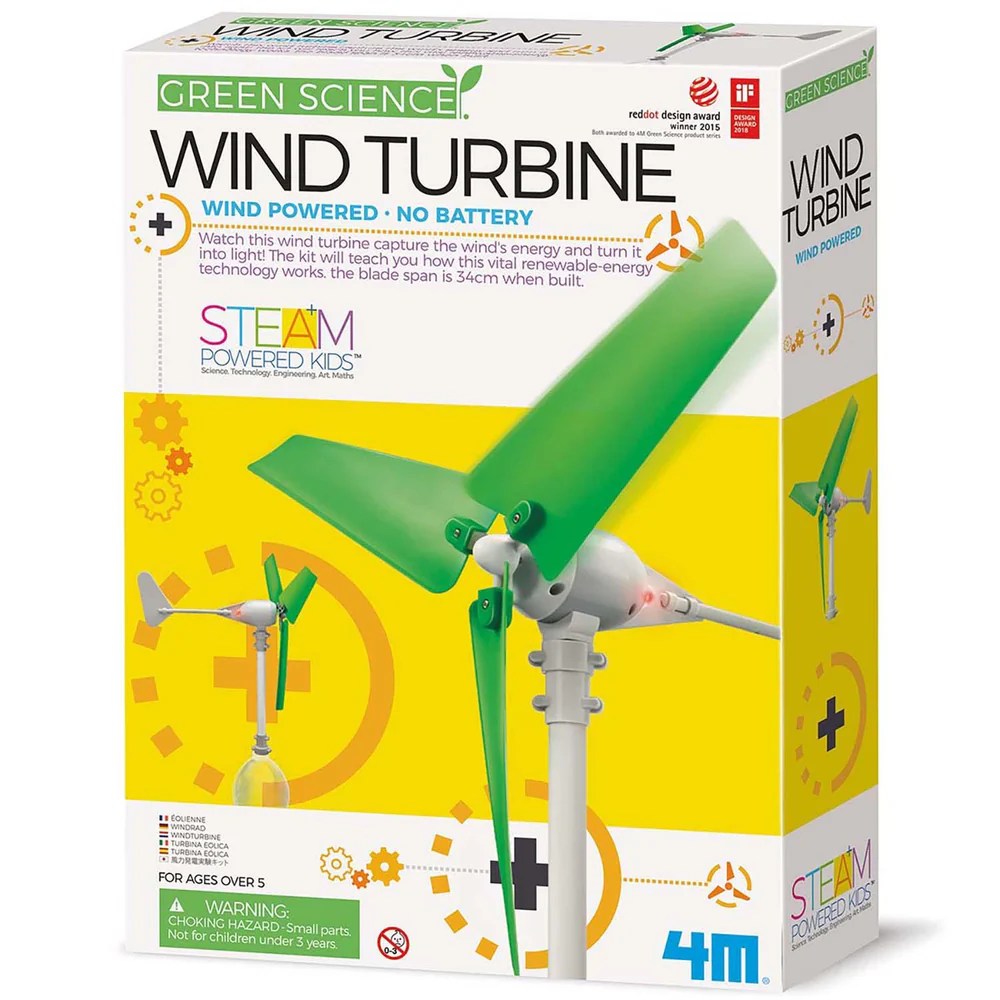
Wind power kits consist of various components that work together to convert wind energy into electricity. These components play specific roles in capturing, converting, and transmitting wind power. The materials used in their construction determine their durability, efficiency, and lifespan.
Wind Turbine
- Blades:Convert wind energy into rotational motion. Typically made of composite materials like fiberglass or carbon fiber for strength and durability.
- Hub:Connects the blades to the shaft and transmits rotational energy. Constructed from materials like cast iron or steel for strength and reliability.
- Shaft:Transfers rotational energy from the hub to the generator. Usually made of steel or composite materials for rigidity and longevity.
Generator
- Rotor:Spins inside the stator, generating electricity through electromagnetic induction. Made of copper or aluminum windings and permanent magnets or electromagnets.
- Stator:Surrounds the rotor, creating a magnetic field. Constructed from laminated steel sheets for efficiency and heat dissipation.
- Output Terminals:Transmit generated electricity to the controller. Typically made of brass or copper for good conductivity.
Controller
- Charge Controller:Regulates the flow of electricity from the generator to the battery, preventing overcharging and damage. Made of electronic components and microcontrollers.
- Inverter:Converts DC electricity from the battery to AC electricity for use in homes or appliances. Constructed from power electronics and transformers.
- Circuit Breaker:Protects the system from electrical overloads or faults. Typically made of metal or plastic with a spring-loaded mechanism.
Tower
- Guy Wires:Stabilize the tower and prevent it from swaying or collapsing. Made of galvanized steel or composite materials for strength and corrosion resistance.
- Base Plate:Connects the tower to the ground and provides a stable foundation. Constructed from concrete, metal, or wood for durability and longevity.
Battery
- Electrodes:Positive and negative plates that store electrical energy. Typically made of lead-acid, lithium-ion, or other battery technologies.
- Electrolyte:A chemical solution that allows ions to flow between the electrodes. Made of sulfuric acid, lithium salts, or other electrolyte materials.
- Separator:Prevents the electrodes from touching and causing a short circuit. Constructed from plastic, fiberglass, or other insulating materials.
Wiring
- Conductors:Carry electricity from one component to another. Made of copper or aluminum for high conductivity and flexibility.
- Insulation:Protects the conductors from short circuits and electrical hazards. Constructed from rubber, plastic, or other insulating materials.
- Connectors:Join wires together and ensure proper electrical connections. Made of brass, copper, or other conductive materials.
Wind Turbine Design
Wind turbines convert the kinetic energy of the wind into electrical energy. The basic design of a wind turbine consists of a rotor, a generator, and a tower. The rotor is composed of blades that are attached to a hub.
The hub is connected to a shaft that drives the generator. The generator converts the mechanical energy of the rotating shaft into electrical energy.
Principles of Aerodynamics
The operation of wind turbines is governed by the principles of aerodynamics. The shape of the blades and the angle at which they are set are designed to create lift, which is the force that opposes gravity and keeps the blades rotating.
The lift is generated by the difference in air pressure between the two sides of the blade. The air pressure is lower on the side of the blade that is facing the wind, and higher on the side that is facing away from the wind.
This difference in air pressure creates a force that pushes the blade forward, causing it to rotate.
Factors Affecting Efficiency
The efficiency of wind turbines is affected by a number of factors, including the wind speed, the size of the rotor, and the design of the blades. The wind speed is the most important factor, as the power output of a wind turbine is proportional to the cube of the wind speed.
The size of the rotor is also important, as larger rotors can capture more wind energy. The design of the blades is also important, as blades that are designed to create more lift will be more efficient.
Wind Power Generation
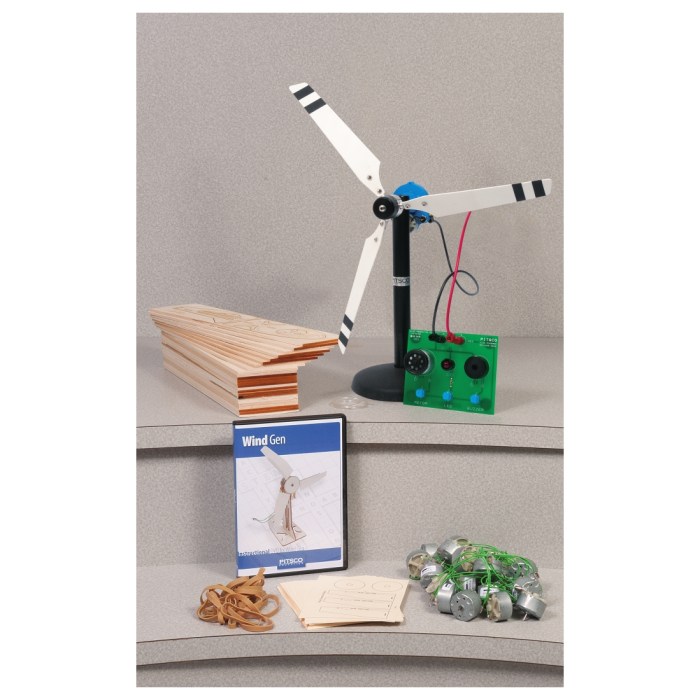
Wind turbines convert the kinetic energy of the wind into electrical energy. The process involves several key steps:
Wind Turbine Blades
- As the wind blows, it strikes the blades of the turbine, causing them to rotate.
- The blades are designed to be aerodynamic, allowing them to capture the maximum amount of wind energy.
- The rotation of the blades creates a mechanical force that drives the turbine’s generator.
Generator
- The generator is a device that converts mechanical energy into electrical energy.
- As the turbine blades rotate, they spin the generator’s rotor, which creates an electrical current in the generator’s stator.
- The electrical current is then sent to a transformer, which increases the voltage so that it can be transmitted to the grid.
Factors Affecting Electricity Generation, Wind power kit science olympiad
- Wind speed:The amount of electricity generated is directly proportional to the wind speed. Higher wind speeds generate more electricity.
- Turbine size:Larger turbines can capture more wind energy and generate more electricity.
- Turbine efficiency:The efficiency of a turbine determines how much of the wind’s kinetic energy is converted into electrical energy.
- Site location:The location of a turbine can significantly affect its electricity generation. Turbines located in areas with consistent high wind speeds will generate more electricity than those located in areas with low wind speeds.
Wind Power Applications
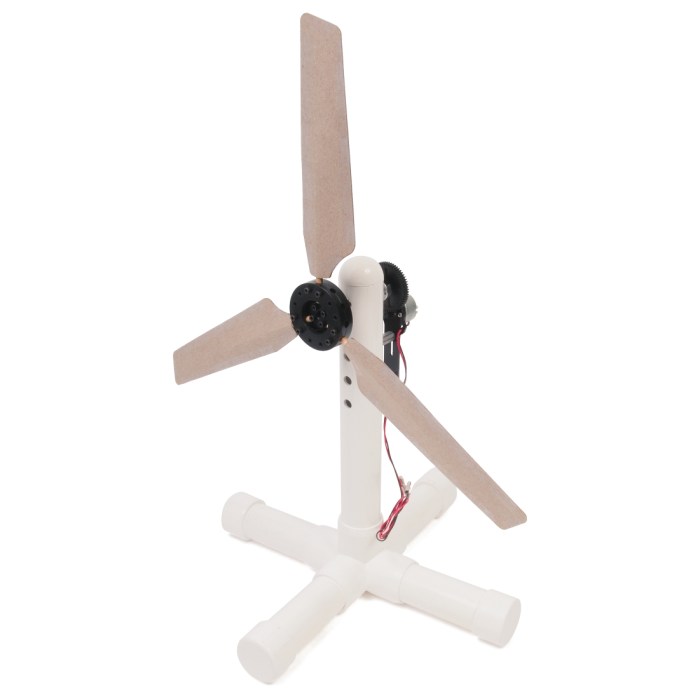
Wind power has a wide range of applications, including electricity generation, water pumping, and mechanical energy production. Wind turbines can be used in both onshore and offshore settings, and they can provide a significant source of renewable energy.
One of the most common applications of wind power is electricity generation. Wind turbines can be used to generate electricity for homes, businesses, and communities. Wind-generated electricity is a clean and renewable source of energy, and it can help to reduce our dependence on fossil fuels.
Advantages of Wind Power
- Wind power is a clean and renewable source of energy.
- Wind turbines can be used in both onshore and offshore settings.
- Wind power can help to reduce our dependence on fossil fuels.
- Wind power is a cost-effective source of energy.
Disadvantages of Wind Power
- Wind power is intermittent, meaning that it is not always available.
- Wind turbines can be noisy and unsightly.
- Wind turbines can interfere with wildlife.
Comparison of Wind Power to Other Renewable Energy Sources
Wind power is a competitive renewable energy source when compared to other options such as solar and hydropower. Wind turbines have a lower capacity factor than solar panels, but they are generally more cost-effective. Wind turbines also have a lower environmental impact than hydropower dams, which can disrupt fish migration and alter river ecosystems.
| Renewable Energy Source | Capacity Factor | Cost | Environmental Impact |
|---|---|---|---|
| Wind Power | 35-45% | $0.05-0.10 per kWh | Low |
| Solar Power | 20-30% | $0.10-0.20 per kWh | Low |
| Hydropower | 50-80% | $0.02-0.06 per kWh | High |
Wind Power Kit Assembly
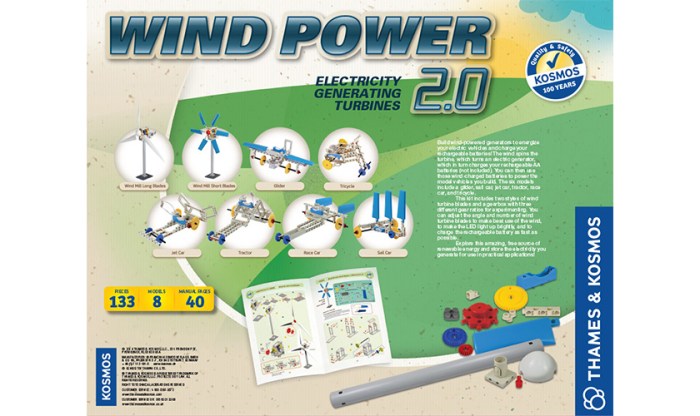
Assembling a wind power kit requires careful planning and execution. Follow these steps to ensure a successful installation:
Materials and Tools
- Wind power kit components (turbine, blades, tower, controller, etc.)
- Wrench
- Screwdriver
- Electrical tape
- Wire cutters
- Safety glasses
Safety Precautions
- Wear safety glasses and gloves.
- Work in a well-ventilated area.
- Do not attempt to assemble the kit in high winds.
- Ensure that the area around the turbine is clear of obstacles.
Step-by-Step Guide
- Assemble the tower:Follow the manufacturer’s instructions to assemble the tower sections.
- Install the turbine:Mount the turbine on top of the tower and secure it with bolts.
- Attach the blades:Connect the blades to the turbine hub and tighten the bolts.
- Wire the turbine:Connect the turbine’s wires to the controller according to the wiring diagram.
- Mount the controller:Install the controller in a protected location near the turbine.
- Connect the battery:Connect the battery to the controller and secure it with electrical tape.
- Test the system:Turn on the system and check that the turbine is spinning and generating electricity.
Troubleshooting Tips
- If the turbine is not spinning, check the wiring connections and ensure that the blades are not obstructed.
- If the turbine is spinning but not generating electricity, check the controller settings and the battery connections.
- If the battery is not charging, check the battery terminals and the controller settings.
Wind Power Kit Experimentation
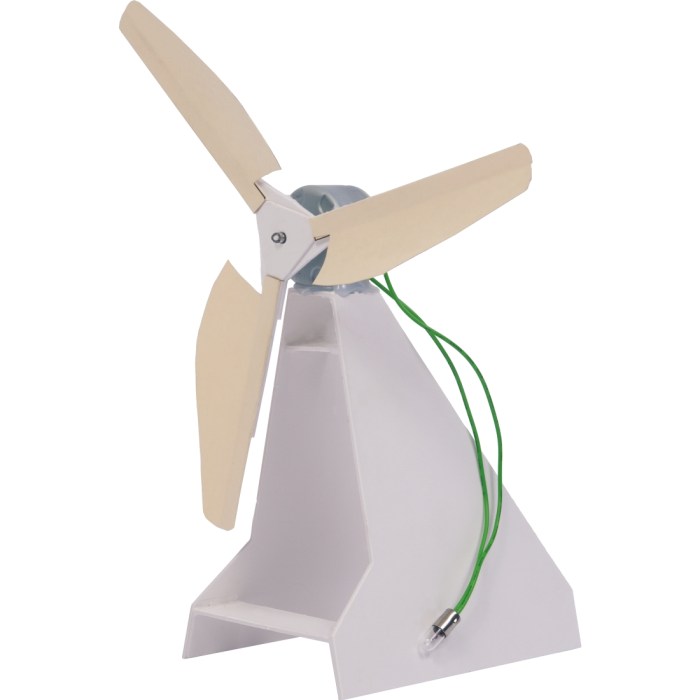
Conducting experiments with a wind power kit is crucial for evaluating its performance and understanding its capabilities. By designing a well-structured experiment, researchers can systematically test the kit’s efficiency, power output, and other relevant parameters.
To ensure accurate and meaningful results, it is essential to identify the variables to be measured and establish appropriate methods for data collection. Common variables include wind speed, turbine rotational speed, voltage, and current. Data collection methods may involve the use of anemometers, tachometers, voltmeters, and ammeters.
Data Analysis
Once data is collected, it must be carefully analyzed to draw conclusions about the performance of the wind power kit. Statistical analysis techniques, such as linear regression and correlation analysis, can be employed to determine the relationship between variables and identify trends.
By analyzing the results, researchers can assess the efficiency of the turbine, its power output under varying wind conditions, and any potential limitations or areas for improvement. This information can be used to optimize the design and operation of the wind power kit for specific applications.
Wind Power Kit Troubleshooting: Wind Power Kit Science Olympiad
Wind power kits are generally reliable, but they can occasionally experience problems. Common issues include:
- Low power output:This can be caused by a variety of factors, including insufficient wind, a poorly positioned turbine, or a problem with the generator.
- Noise:Wind turbines can generate noise, which can be a problem in residential areas. There are a number of ways to reduce noise, such as using a quieter turbine or installing a sound barrier.
- Vibration:Wind turbines can also vibrate, which can damage the turbine or the structure it is mounted on. Vibration can be reduced by using a vibration damper or by installing the turbine on a sturdy foundation.
Troubleshooting tips for these problems include:
- Low power output:Check the wind speed and make sure the turbine is positioned in a location where it will receive adequate wind. Check the generator for any problems.
- Noise:Try using a quieter turbine or installing a sound barrier. You can also try adjusting the angle of the blades to reduce noise.
- Vibration:Use a vibration damper or install the turbine on a sturdy foundation. You can also try adjusting the angle of the blades to reduce vibration.
Regular maintenance and repair can help to keep wind power kits operating properly. Maintenance tasks include:
- Inspecting the turbine:Look for any damage to the blades, tower, or generator.
- Cleaning the turbine:Remove any dirt or debris from the blades and tower.
- Lubricating the turbine:Lubricate any moving parts to reduce wear and tear.
- Tightening the bolts:Make sure all of the bolts on the turbine are tight.
If you experience any problems with your wind power kit, it is important to troubleshoot the problem and make any necessary repairs. By following these tips, you can keep your wind power kit operating properly for many years to come.
FAQ Guide
What are the key components of a wind power kit?
A typical wind power kit includes a wind turbine, generator, blades, tower, and controller.
How does a wind turbine convert wind energy into electricity?
As the wind strikes the turbine blades, it creates kinetic energy, which is then converted into electrical energy by the generator.
What factors affect the efficiency of a wind turbine?
Efficiency is influenced by blade design, wind speed, and tower height, among other factors.
